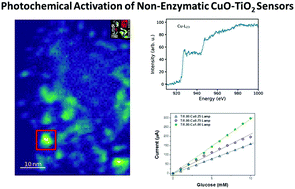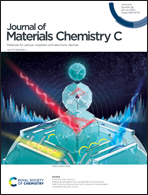Photo-electrochemical properties of CuO–TiO2 heterojunctions for glucose sensing†
Abstract
Electrochemical sensors for monitoring biochemical substances are attracting considerable attention. These devices are usually based on enzymes that are sensitive and very specific. Still, the activity of those enzymes is lost with changes in temperature or pH. Non-enzymatic electrochemical sensors – fabricated via the modification of the electrode surface with metal oxide nanoparticles – are an ideal answer to address that problem. In this study, we investigated the photo-electrochemical properties of CuO–TiO2 heterojunctions for glucose sensing in alkaline media. A combination of high-resolution (scanning) transmission electron microscopy, spatially resolved electron energy-loss spectroscopy, energy-dispersive X-ray spectroscopy and X-ray powder diffraction, was used to study in detail the microstructures of the prepared specimens. These results highlighted the strong intertwining between the TiO2 nanoparticles and the Cu-based nanoparticles, which present a metallic core with a CuO rich surface. In addition, we showed that CuO, joint to TiO2, has smaller size compared to pure CuO, which entails larger specific surface area available for the glucose electro-oxidation, which consequently enhanced the electrochemical features. The influence of Cu loading over the sensing performance of TiO2 was examined in detail carrying out electrochemical sensing tests under dark, laboratory and halogen lamp irradiation conditions. Results demonstrated that, under halogen lamp irradiation, modified CuO–TiO2 electrodes showed a specific response signal that is four times higher than that of pure CuO. Those increased photo-electrochemical properties in CuO–TiO2 heterojunctions are likely due to a synergistic effect between the microstructural characteristics and effective separation of photo-generated excitons created at the heterojunction interface. Results of this study offer applicable guidelines for designing photo-electrochemical screen-printed electrodes based on nano-sized CuO on titania for efficient detection of glucose.



 Please wait while we load your content...
Please wait while we load your content...